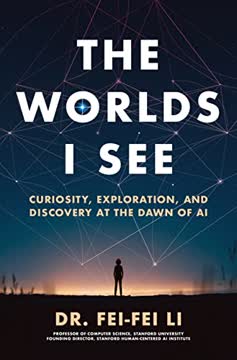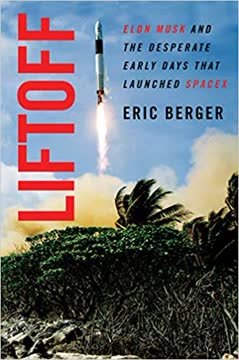Key Takeaways
1. The Space Race Reborn: Billionaires Compete to Revolutionize Space Travel
"If achieving the impossible was the goal, then a single rocket explosion was a mere speed bump, not a roadblock—a temporary inconvenience, not a catastrophe."
A new era of space exploration. The early 21st century saw a remarkable shift in space exploration, with billionaire entrepreneurs taking the lead. Elon Musk (SpaceX), Jeff Bezos (Blue Origin), Richard Branson (Virgin Galactic), and Paul Allen (Stratolaunch) invested their fortunes and visions into private space companies. Their motivations ranged from reducing launch costs to colonizing Mars, but all shared a common goal: revolutionizing access to space.
Competing visions and approaches. Each billionaire brought a unique strategy to the table:
- Musk: Focused on rapid development and Mars colonization
- Bezos: Patient, step-by-step approach to building space infrastructure
- Branson: Emphasized space tourism and suborbital flights
- Allen: Developed a massive plane for air-launching rockets
This competition drove innovation, challenged traditional aerospace companies, and reignited public interest in space exploration. The race between these "Space Barons" echoed the Cold War space race, but with private individuals playing the roles once reserved for nations.
2. SpaceX: Musk's Relentless Push for Reusable Rockets and Mars Colonization
"Head down. Plow through the line. That's very SpaceX."
Rapid innovation and ambitious goals. Elon Musk founded SpaceX in 2002 with the ultimate goal of colonizing Mars. The company's approach was characterized by:
- Vertical integration: Building most components in-house
- Rapid prototyping and iterative design
- Pursuing reusable rockets to dramatically reduce launch costs
Key milestones:
- 2008: First successful orbital launch of Falcon 1
- 2012: First private company to dock with the International Space Station
- 2015: First successful landing of an orbital-class rocket booster
- 2017: First reuse of an orbital-class rocket booster
SpaceX's successes challenged established aerospace companies and NASA, proving that a private company could innovate quickly and efficiently in the space industry. Musk's vision extended beyond Earth orbit, with plans for a massive rocket (BFR) capable of Mars colonization and even point-to-point travel on Earth.
3. Blue Origin: Bezos' Patient Approach to Building a Space Infrastructure
"Gradatim Ferociter" (Step by step, ferociously)
Long-term vision for space habitation. Jeff Bezos founded Blue Origin in 2000 with a focus on gradually developing the infrastructure needed for millions of people to live and work in space. Key aspects of Blue Origin's approach include:
- Emphasis on reusability and vertical landing technology
- Suborbital tourism as a stepping stone to orbital flight
- Development of larger rockets (New Glenn) for diverse missions
Milestones and projects:
- 2015: First successful vertical landing of a suborbital rocket (New Shepard)
- Plans for lunar lander (Blue Moon) to support NASA missions
- Development of BE-4 engine, potentially powering both Blue Origin and ULA rockets
Bezos sees Blue Origin as laying the groundwork for future generations, comparing it to the early days of aviation or the internet. His patient, methodical approach contrasts with SpaceX's rapid development cycle, reflecting different philosophies in achieving similar long-term goals.
4. Virgin Galactic: Branson's Vision for Commercial Space Tourism
"Screw it, let's do it."
Pioneering space tourism. Richard Branson's Virgin Galactic aims to make suborbital space travel accessible to paying customers. Key features of Virgin Galactic's approach:
- Air-launched spaceplane design (SpaceShipTwo)
- Focus on customer experience and luxury
- Emphasis on safety following fatal 2014 test flight crash
Progress and challenges:
- 2004: SpaceShipOne wins Ansari X Prize
- Ongoing development and testing of SpaceShipTwo
- Delays in achieving commercial operations
Virgin Galactic's efforts have helped popularize the concept of space tourism, generating significant public interest and pre-bookings. However, technical challenges and safety concerns have led to repeated delays in launching commercial services. Branson's marketing prowess and optimism have been crucial in maintaining momentum despite setbacks.
5. Stratolaunch: Allen's Massive Plane for Air-Launching Rockets
"You have a certain number of dreams in your life you want to fulfill. And this is a dream that I'm very excited about."
Innovative air-launch system. Paul Allen, co-founder of Microsoft, developed Stratolaunch to create a flexible, air-launch platform for satellites and potentially crewed spacecraft. Key features:
- World's largest airplane by wingspan (385 feet)
- Capable of carrying multiple rockets for air-launch
- Potential for rapid, responsive satellite deployment
Development and potential:
- First rollout in 2017
- Designed to launch Pegasus XL rockets initially
- Exploration of developing own launch vehicle (Black Ice spaceplane concept)
Stratolaunch represents a unique approach to space access, leveraging Allen's passion for aviation and space. The massive scale of the aircraft and its potential for flexible, responsive launches set it apart from other private space ventures. While progress has been slower than some competitors, the project demonstrates the diverse approaches being explored in the new space race.
6. The Moon: A Renewed Focus as a Stepping Stone to Deep Space
"It's 2017; we should have a lunar base by now. What the hell has been going on?"
Lunar ambitions rekindled. After decades of focus on low Earth orbit and Mars, the Moon has reemerged as a crucial target for both government and private space programs. Key factors driving this renewed interest:
- Potential for in-situ resource utilization (e.g., water ice for fuel)
- Testing ground for technologies needed for Mars missions
- Commercial opportunities in lunar cargo delivery and habitats
Lunar initiatives:
- NASA's Artemis program aiming for crewed lunar landings
- SpaceX's plans for circumlunar tourism flights
- Blue Origin's "Blue Moon" lunar lander concept
- Commercial cargo delivery proposals from multiple companies
The Moon is increasingly seen as a logical next step in space exploration, offering a nearby proving ground for technologies and operational concepts needed for deeper space missions. Private companies are positioning themselves to support government lunar programs while also exploring commercial opportunities on and around the Moon.
7. Overcoming Setbacks: Explosions, Crashes, and the Resilience of Space Entrepreneurs
"Space is hard."
Persistence through failure. The path to revolutionizing space access has been marked by significant setbacks for all the major private space companies. Key incidents include:
- SpaceX: Multiple rocket explosions during testing and launches
- Virgin Galactic: Fatal crash of SpaceShipTwo in 2014
- Blue Origin: Early test vehicle crashes
Response and recovery:
- Rapid investigation and return to flight
- Transparency in communicating failures and lessons learned
- Iterative design improvements based on failure analysis
These setbacks have demonstrated the inherent risks of spaceflight while also showcasing the resilience and adaptability of the new space companies. Unlike traditional aerospace contractors, these companies have often responded to failures with increased transparency and rapid iteration, turning setbacks into opportunities for improvement and public engagement.
8. NASA's Evolution: From Government Monopoly to Commercial Partnerships
"If we want, we could have a trillion human beings living in the solar system. And then we'll have a thousand Einsteins, and a thousand Mozarts. What a cool civilization that would be."
Shifting paradigm in space exploration. NASA's relationship with the private sector has undergone a significant transformation:
- Traditional model: NASA as primary customer and overseer of contractors
- New model: Public-private partnerships with shared investment and risk
Key programs driving change:
- Commercial Orbital Transportation Services (COTS)
- Commercial Crew Program
- Lunar payload services
This evolution has allowed NASA to leverage private sector innovation and efficiency while focusing its resources on deep space exploration and scientific missions. The success of companies like SpaceX in delivering cargo and eventually crew to the International Space Station has validated this new approach, potentially accelerating progress in space exploration.
9. The Economic Potential of Space: Satellites, Mining, and Beyond
"There's all kinds of interesting stuff you can do around the solar system, but the thing that's going to move the needle for humanity the most is mining near-Earth objects and building manufacturing infrastructure in place."
Expanding space economy. Beyond traditional satellite and launch markets, new commercial opportunities in space are emerging:
- Mega-constellations for global internet coverage
- Asteroid and lunar resource extraction
- In-space manufacturing
- Space tourism and private space stations
Driving factors:
- Decreasing launch costs due to reusable rockets
- Miniaturization of satellite technology
- Advances in robotics and artificial intelligence
- Growing investment in space startups
The potential economic value of space activities is driving increased investment and innovation. While many of these opportunities remain speculative, they represent a significant expansion of the space economy beyond traditional government and communications markets.
10. Inspiring a New Generation: Reigniting Public Interest in Space Exploration
"I think that if you go to the moon first, and make the moon your home, then you can get to Mars more easily."
Rekindling the space dream. The efforts of private space companies have helped revitalize public interest in space exploration:
- High-profile launches and landings capturing global attention
- Ambitious goals like Mars colonization sparking imagination
- Increased media coverage of space activities
Educational and cultural impact:
- Growing enrollment in aerospace engineering programs
- Space-themed entertainment and merchandise
- Social media engagement around space events
The visibility and ambition of the new space race have helped counter decades of waning public interest following the Apollo program. By making space feel accessible and relevant again, these entrepreneurs are inspiring a new generation to pursue careers in science, technology, engineering, and mathematics, potentially accelerating progress in space exploration and related fields.
Last updated:
FAQ
What's The Space Barons about?
- Focus on Space Entrepreneurs: The Space Barons by Christian Davenport delves into the rise of private space companies led by billionaires like Elon Musk, Jeff Bezos, Richard Branson, and Paul Allen. It highlights their ambitions to revolutionize space travel and colonization.
- Historical Context: The book provides a backdrop of the U.S. space program, illustrating the shift from government-led missions to private sector involvement. It discusses the challenges and successes faced by these entrepreneurs.
- Rivalry and Innovation: The narrative centers on the rivalry between Musk's SpaceX and Bezos's Blue Origin, showcasing their different approaches to achieving similar goals in the space industry.
Why should I read The Space Barons?
- Insight into Modern Space Race: The book offers a detailed look at the new era of space exploration driven by private enterprise, providing context for understanding how these companies are changing the landscape of space travel.
- Profiles of Key Figures: Readers gain insights into the personalities and motivations of influential figures like Musk and Bezos, exploring their contrasting styles and philosophies.
- Inspiration and Vision: Davenport captures the audacity and vision of these entrepreneurs, inspiring readers to think about the future of humanity in space and encouraging a sense of wonder about what is possible.
What are the key takeaways of The Space Barons?
- Shift to Commercial Spaceflight: The book emphasizes the transition from government-led space exploration to private companies taking the lead, reshaping how we think about space travel and its accessibility.
- Importance of Reusability: A major theme is the focus on developing reusable rockets, which can drastically reduce the cost of space travel, making it more accessible.
- Cultural Impact: The narrative discusses how these ventures are reigniting public interest in space exploration, akin to the excitement of the Apollo missions, suggesting that the future of space travel is not just about technology but also about inspiring a new generation.
What are the best quotes from The Space Barons and what do they mean?
- “Screw it, let’s do it.”: This quote from Richard Branson encapsulates the adventurous spirit of the new space entrepreneurs, reflecting a willingness to take risks and pursue ambitious goals.
- “Space is hard.”: A recurring theme in the book, this phrase acknowledges the inherent difficulties in space exploration, serving as a reminder that perseverance and innovation can lead to breakthroughs.
- “The Falcon 9 has landed.”: This statement marks a historic moment for SpaceX, symbolizing the successful landing of a reusable rocket and signifying a major milestone in making space travel more sustainable.
How do Elon Musk and Jeff Bezos differ in their approaches to space exploration in The Space Barons?
- Musk's Boldness vs. Bezos's Caution: Musk is portrayed as the audacious "hare," pushing aggressively for rapid advancements, while Bezos is depicted as the "tortoise," taking a more methodical approach.
- Public Engagement: Musk often engages with the public and media, using social media to generate excitement, whereas Bezos maintains a lower profile, focusing on long-term goals.
- Vision for the Future: Musk's vision includes colonizing Mars, while Bezos emphasizes building infrastructure in space to support human life, reflecting their unique motivations and strategies.
What challenges did SpaceX face in its early years as described in The Space Barons?
- Launch Failures: SpaceX experienced multiple launch failures, including the Falcon 1's first three attempts, which were critical setbacks but also learning opportunities.
- Funding and Financial Strain: Musk invested a significant portion of his personal fortune into SpaceX, creating a precarious financial situation that required securing contracts and funding to survive.
- Skepticism from Industry: The established aerospace industry viewed SpaceX as a risky venture, often dismissing its potential, which Musk had to overcome to prove that a private company could succeed in space.
How did Blue Origin's approach differ from SpaceX's according to The Space Barons?
- Gradual Development: Blue Origin focused on a step-by-step approach, emphasizing safety and reliability over rapid progress, contrasting with SpaceX's aggressive timeline.
- Secrecy vs. Transparency: Blue Origin operated largely in secrecy, while SpaceX was open about its goals and progress, reflecting their contrasting corporate cultures.
- Long-Term Vision: Bezos's vision includes creating a sustainable human presence in space, focusing on infrastructure, while Musk aims for Mars colonization and rapid technological advancements.
What role did the X Prize play in the narrative of The Space Barons?
- Catalyst for Innovation: The X Prize motivated private space ventures, encouraging entrepreneurs to develop commercial spacecraft and spurring innovation and public interest.
- Historical Context: It reignited the spirit of competition reminiscent of the Apollo era, highlighting the importance of private initiatives in advancing space technology.
- Success of SpaceShipOne: SpaceShipOne's success in winning the X Prize demonstrated that private companies could achieve what was once thought to be the sole domain of governments, laying the groundwork for future ventures.
How does The Space Barons address the future of space exploration?
- Commercialization of Space: The book argues that the future of space exploration lies in the hands of private companies, leading to more innovation and accessibility.
- Potential for Space Tourism: Davenport discusses the burgeoning industry of space tourism, highlighting efforts to make space travel available to the public.
- Long-Term Human Presence: The narrative emphasizes establishing a sustainable human presence in space, with Musk and Bezos aiming to create the necessary infrastructure for future generations.
What impact have Musk and Bezos had on the space industry as described in The Space Barons?
- Disruption of Traditional Models: Both entrepreneurs have challenged the established aerospace industry, pushing for lower costs and increased access to space.
- Inspiration for Future Generations: They have reignited public interest in space exploration, inspiring a new generation of engineers and dreamers.
- Collaboration with NASA: Partnerships between NASA and these private companies have changed the landscape of space exploration, allowing for innovative solutions to complex problems.
How does The Space Barons portray the personalities of Musk and Bezos?
- Musk's Charisma and Brashness: Musk is depicted as a charismatic and often brash leader, unafraid to take risks and push boundaries, rallying support for SpaceX.
- Bezos's Methodical and Reserved Nature: Bezos is portrayed as more reserved and methodical, focusing on long-term goals and careful planning, characterized by patience.
- Rivalry and Respect: Despite their differences, the book highlights a mutual respect between the two billionaires, acknowledging their shared passion for space exploration.
How did NASA's approach to space exploration change with the rise of private companies?
- Commercial Partnerships: NASA shifted to include partnerships with private companies, allowing for greater innovation and efficiency in space missions.
- Cost-Effectiveness: Recognizing that private companies could provide services at a lower cost, NASA adopted a more collaborative approach.
- Focus on Deep Space: With commercial partners handling low Earth orbit missions, NASA could refocus on ambitious deep space exploration goals, such as Mars missions.
Review Summary
The Space Barons receives mixed reviews, with many praising its thorough examination of private space exploration and the billionaires driving it. Readers appreciate the insights into Elon Musk, Jeff Bezos, and others, as well as the industry's challenges and achievements. Some criticize the book's organization, repetitiveness, and perceived bias towards certain figures. Overall, it's considered an informative read for those interested in the current state of commercial spaceflight, though some feel it lacks depth in certain areas.
Similar Books










Download PDF
Download EPUB
.epub digital book format is ideal for reading ebooks on phones, tablets, and e-readers.




